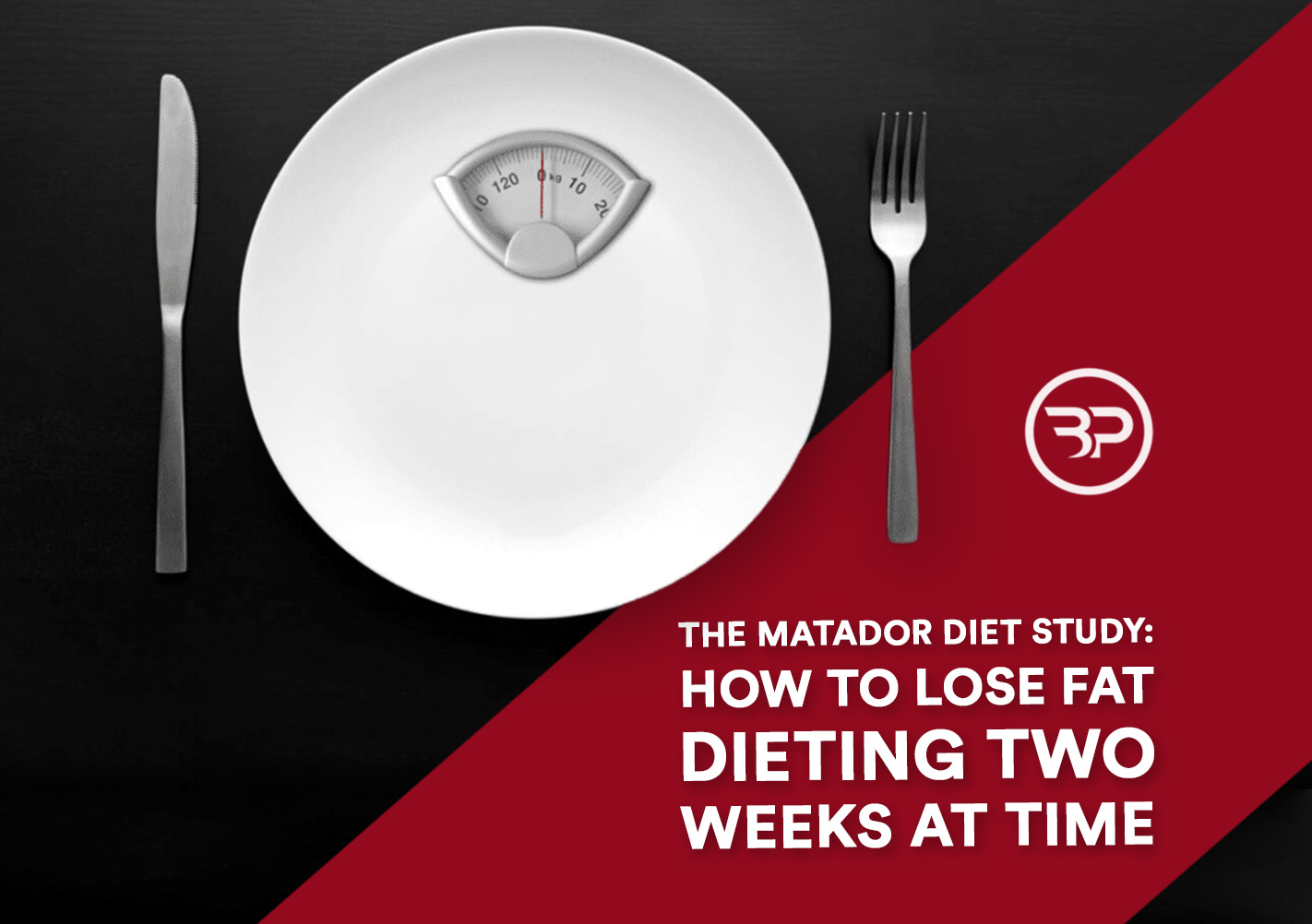The Matador Diet Study: How to Lose Fat Dieting Two Weeks at Time
September 26, 2018
The Matador diet is a ground-breaking fat loss method that alternates a caloric deficit with eating at calorie maintenance in two week periods. By alternating calories, you’re able to minimize metabolic adaptions, such as a slowing metabolism. As a result, you can stick to this diet longer, have a more balanced lifestyle, and ultimately lose fat.
Is the Matador Diet Method for you?
Lots of people train hard and try to eat healthy, but struggle to lose fat and build the body they want. They fall prey to fads and gimmicks.
They’re sick of being out of shape and feeling unhealthy. They’re baffled by painstakingly slow fat loss and minimal strength and muscle gains.
Sound familiar?
You may not necessarily want to stagger onto a bodybuilding stage in a spray tan and a banana hammock. You just want to look good naked in front of the mirror (or someone else) each morning. And damn it, you want to feel confident with your shirt off at the beach.
Help is on the way, my friends, in the form of the best method I’ve found: an intermittent energy restriction diet.
What The Heck Is The Intermittent Energy Restriction Diet?
First, fat loss comes down to burning more calories than you take in.
Intermittent energy restrictions diets use intermittent diet periods (generally two weeks) of a strict caloric deficit of 30-35%, followed by two weeks at maintenance calories. You’ll use an aggressive approach for two weeks, then scaling back to maintenance calories to prevent metabolic adaptation (or slow down) in response to eating fewer calories.
Weeks 1-2: Aggressive diet with 30% deficit.
Weeks 3-4: Maintenance Calories
More on this in a minute. But before we get there, let’s dig into the “slow and steady” approach of using consistent energy restriction for long periods of time, then come back full circle.
Typical Consistent Energy Restriction Diets
A typical diet uses consistent energy restriction-reduces calories for a long period of time.
Weeks 1-4: 10% Caloric deficit
This works wonders for some people. But what about others, like the busy professionals I work with who have families, busy careers, and enjoy a good meal or cocktail during the weekend?
They’ll be great all week, then miss the boat on the weekends. They’ll eat for a 500 calorie deficit Sunday-Friday (3000 calorie deficit), then have a 3,250 calorie surplus on Saturday. Because they’re still in a caloric surplus at the end of the week, they fail to lose fat. Or they make progress so slowly they throw in the towel and say fuck it.
Sure, you can say suck it up and be more disciplined, but my job as a coach is to find a sustainable long-term approach to health and fitness, not belittle adults for having too many IPAs on Saturday. Ranting aside, let’s look at some of the research, starting with the Matador Study.
The Matador Study
Beyond having the best name of any nutritional study in history, the Matador study (Minimising Adaptive Thermogenesis And Deactivating Obesity Rebound) found greater weight loss was achieved using intermittent energy restriction.
You can read the study here if it gets your rocks off.
The Problem With Diets
I’m going to keep this as painless as possible.
Dieting is not healthy. Your body hates it more than Fox News hates CNN. Hell, your body hates dieting more than I hate BOTH Fox News and CNN.
Your body wants to store fuel as a survival mechanism should it have to go for long periods of time without food. That’s what makes weight loss so hard. When you stick in a caloric deficit for a long time…

- Your performance will decrease and weights feel glued to the floor.
- Your mood will crater and you’ll get hangry.
- You’ll get stressed, your sex drive can plummet, and hormones start flippin’ you the bird.
- Your metabolism picks up an ax and starts to fight back. Soon, the “caloric deficit” you were in no longer works. You start adding fat, despite working your ass off and eating like a bird.
As my friends at Precision Nutrition put it, when energy in goes down, energy out goes down to match it. Your resting metabolic rate decreases, you burn fewer calories during exercise, the thermic effect of food decreases, and you start to absorb more calories from your food because your body needs the nourishment.
This is why you might hop on a 30-day diet, achieve incredible results, then completely plateau. When you eat less and less, you don’t make any progress and instead, are digging yourself into a deeper hole without knowing it or having a good coach to guide you.
Sounds pretty shitty, right?
It is.
Unfortunately, I’m seeing more and more men and women fall into this trap and coming to me with a completely jacked up metabolism after months or years of failed dieting. It takes months of reverse dieting to undo this damage before it’s safe and intelligent to get back onto a fat loss diet.
Here’s Why Intermittent Energy Restrictive Diets Are Superior
Using a cyclical approach to fat loss, you’re able to push your body to burn body fat over the course of two weeks. As your body begins to fight back and slow down your metabolism and decrease thyroid function, you increase calories.
Increasing calories back to maintenance will boost your hormone profile back up.
You’ll feel better.
You’ll perform better in the gym.
And when you hop back onto an aggressive fat loss diet for two weeks, your hormones will be firing at full throttle and lean to greater fat loss.
The Mental Game
No diet works for everyone. This is no different.
Personally, I’m a Type-A guy. I go hard in sports, fitness, and business, then I need time to recover.
For the last photoshoot I did I pushed too hard for too long. After the shoot, I devoured ice cream, donuts, pizza, plenty of beer and tequila on back to back nights in New York City. Three days later I went to Cancun for five days of debauchery and finally arrived back in Denver 20 pounds heavier than the week before.
Not. Good. Nor something I’d recommend. But it’s an example of what can happen if you push too hard for too long. I had a blast though.
 If You’re A Hard Charging, Type A Individual…
If You’re A Hard Charging, Type A Individual…
You’ll thrive with this diet.
You’ll leverage the extreme levels of motivation and discipline you have for long enough to make changes.
Then, you’ll dial back to a sustainable approach for two weeks before another sprint.
If You’re A Laid Back, More Type B Individual?
Give the intermittent energy restriction diet a shot.
Generally speaking, you’re probably better more even-keeled and can work towards a steady goal for long periods of time than most type-A folks and because of this, are more likely to succeed with a consistent caloric deficit.
Setting Up An Intermittent Energy Restriction Diet
You’re going to alternate two week time periods of aggressive fat loss with eating at maintenance, the number of calories you need to maintain your current weight.
Calculating Caloric Maintenance:
The best way to find out your true maintenance is to get tested by a qualified professional. Every other number is an estimation. If you’ve been yo-yo dieting for a long time, your maintenance calories may be much lower.
Option A: Go to a qualified professional to get an accurate resting metabolic rate (RMR) then measure physical activity. Frankly, I’m not that obsessive. I found other options to be close enough.
Option B: Calculators
Try this at Bodybuilding.com strength.
Let’s say your maintenance calories come out to 2,000 calories per day.
We want your caloric deficit to be 30%, so we’ll multiply 2,000 x.7= 1400 calories.
Your Diet Would Look Like This:
Two Week Diet Phase: 1400 calories/day
Two Week Maintenance Phase: 2000 calories/day
After the month, recalculate your maintenance calories based on your new bodyweight. Rise and repeat until desired leanness.
For your macros…
When it comes to fat loss your most important variable is protein intake. Eat 1 g per 1/lb of body weight to maintain lean muscle mass during your diet. If you have protein questions, read this go-to guide.
Carbs and fats: Frankly, arguing carbs and fats is minoring in the minutiae. If you nail your calories and protein you will lose fat. Eat carbs and fats as it fits you.
For your workouts…
Lift heavy to preserve strength and muscle even when in a caloric deficit. You may need to reduce the volume (fewer sets and reps) to limit cortisol, which can stop fat loss in its tracks. Walk daily and do sprints twice per week. You’ll love the workouts in the Bach Performance Physique Coaching Program.
If you’ve been dieting unsuccessfully…
Let’s talk. Chances are you’ll need a specialized approach to ensure your metabolism is firing at full speed. In this case, a reverse diet is needed and any attempts to drop calories further digs you into a deeper hole.
Are you sick and tired of working hard and not building the body you deserve?
Then going it alone or following another cookie-cutter approach isn’t going to keep working. Apply here and I’ll personally coach you to look better naked and find a long-term, sustainable approach to looking, feeling, and performing your best. Start your transformation today.









[…] Matador Diet By Eric Bach […]
Thank you for sharing! This method is amazing! I dropped unwanted, plus, pounds and quicker than I thought possible. The only thing that I did different, I cycled my calories in days, not weeks. Just something that works better for me. I was beginning to think I could not lose weight anymore. With all my heart, I THANK YOU!!!
This blog about Matador Diet | Eric Bach Blog has helped me a lot, is very well written.
I used this fat burner product: https://s96.me/fit and
I reached the ideal weight. Kiss you All!
Hi Eric! I was just wondering, would this mean that the calories stay, regardless of the level of activity for the day? ‘Cause typically, I consume a bit more carbs after a workout; I’m just concerned that I’ll consume more carbs than the 35% or the equivalent grams of it.
Hey Charles, yes that is correct.